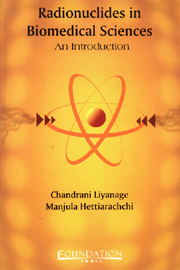Book contents
- Frontmatter
- Contents
- Forewords
- Introduction
- 1 Atomic and Nuclear Structure
- 2 Radiation Detectors
- 3 Units of Radiation Measurements
- 4 Iodine–125
- 5 Radioimmunoassay
- 6 Quality Control in RIA
- 7 Radiolabelled Compounds
- 8 Radiation Safety
- 9 Radiation Protection
- 10 Background Radiation
- 11 Storage
- 12 Contamination
- 13 Radioactive Waste
- References
5 - Radioimmunoassay
Published online by Cambridge University Press: 26 October 2011
- Frontmatter
- Contents
- Forewords
- Introduction
- 1 Atomic and Nuclear Structure
- 2 Radiation Detectors
- 3 Units of Radiation Measurements
- 4 Iodine–125
- 5 Radioimmunoassay
- 6 Quality Control in RIA
- 7 Radiolabelled Compounds
- 8 Radiation Safety
- 9 Radiation Protection
- 10 Background Radiation
- 11 Storage
- 12 Contamination
- 13 Radioactive Waste
- References
Summary
Any investigation involves measurements and the measurement of the quantity of a substance is known as an assay. In medicine, knowledge of the concentrations of different biochemicals such as hormones, drugs, vitamins etc., present in a patient's body serves as an excellent diagnostic tool. Radioimmunoassay (RIA) is now one of the best-known procedures for the estimation of the constituents of human blood present in minute quantities. RIA has all the desirable and essential qualities needed for an analytical technique for precise estimation of many of these ingredients. Presently, immunoassays enjoy an almost unprecedented popularity as methods of choice for quantisation.
The 1960s and 1970s witnessed an increasing interest in immunoassay techniques. Development of the RIA technique was largely carried out by Berson and Yalow of USA and Ekins of UK. The first publication on RIA for ‘insulin’ was in 1960 by Berson and Yalow. Yalow was awarded the Nobel Prize in 1977 for the contribution made to the development of this versatile technique (Berson had passed away in 1972).
There are immunoassays using a variety of detection systems such as radioisotopic measurements, fluorescence, chemiluminescence, agglutination, precipitation and enzyme colour reactions. These are assays carried out in solutions or gels, with liquid phase reagents or with solid phase reagents, with monoclonal antibodies or polyclonal antibodies, and many other variations proliferating around a central theme.
ADVANTAGES OF RIA
RIA offers four potential advances on the previous methodology.
Sensitivity
At the time of Berson and Yalow's publication, the lower limit of detection using established physiochemical procedures was approximately 10-8 to 10-9 moles.
- Type
- Chapter
- Information
- Radionuclides in Biomedical SciencesAn Introduction, pp. 33 - 60Publisher: Foundation BooksPrint publication year: 2008



